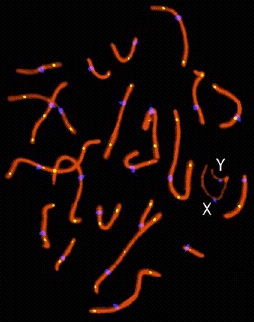http://home.cc.umanitoba.ca/~frist/PLNT3140/as1/as1.html
Assignment 1
Sept. 24,
2024
This assignment is worth 5% of the course grade.
Due: Tue. Oct. 1, 2024.
Chromosomes from human meiotic cells.
|

|
1. (1 point) Recalling that the human genome has 23 chromosome
pairs, from what stage of meiosis was the cell that is shown in the
figure above? Explain your reasoning.
Hint: X and Y chromosomes are labelled. Also keep in mind that on
chromosome spreads, chromosomes sometimes overlap one another,
depending on how the cells break apart on the slide.
2. (3 points) Three proteins were identified on these chromosomes,
using fluorescently-tagged antibodies each specific for one of 3
proteins: the kinetochore protein CREST, SYCP3/SYCP1 proteins from
the synaptonemal complex, or the DNA mismatch repair enzyme
MLH1. Each antibody fluoresces in a different colour, either
red, yellow or purple. Using a table similar to the one below,
tell which protein corresponds to which fluorescent dye, and explain
your rationale for those choices.
fluorescent tag
|
protein
|
explanation
|
red
|
|
|
yellow
|
|
|
purple
|
|
|
3. (1 point) Based on your answers to question 2, draw a diagram
showing a human autosome (ie. other than X or Y) at diakinesis.
Indicate on your diagram where you would expect to see antibody
fluroescnce to MLH1, CREST and SYCP3/SYCP1. Use arrows, labels,
shading, dots etc. to indicate more clearly where the signals for
each of these proteins would be found on chromosomes at
diakinesis/metaphaseI.
Submitting
your assignment
- Make sure your assignment report includes your name, student
number and UM email address.
- Include in your report the diagram described in Question 3.
- Save your assignment report as a PDF file, and upload it to
the PLNT3140 UMLearn dropbox site in the Assignment 1 folder.
Files in word processing formats (.doc, .docx, .rtf, .odt) are NOT
acceptable.
If you don't know how to put diagrams into documents, or export
documents to PDF files, contact me.
Note on grading: In assigning a grade, some consideration
may be given to how the answer communicates your ideas. Keep in
mind the following:
- use of precise and appropriate biological terms
- organization of ideas in your answer, so that a clear chain of
logic is apparent. Formatting tools such as s subheadings or
bullet points help to show the reader the structure of your
ideas
- ambiguity - Try to read your answers from the viewpoint of
your reader. Are there several possible ways to interpret what
you have said?
- Feel free to use figures or tables in cases where they will be
useful get across your ideas.
Note on academic integrity: The results shown in this
assignment may be derived from the research literature. It will be
considered a breach of academic integrity to search for the paper on
the Internet and simply copy the author's conclusions from the
paper.
Notes: If you
have questions, it may help to send me a messge at
frist@cc.umanitoba.ca.

